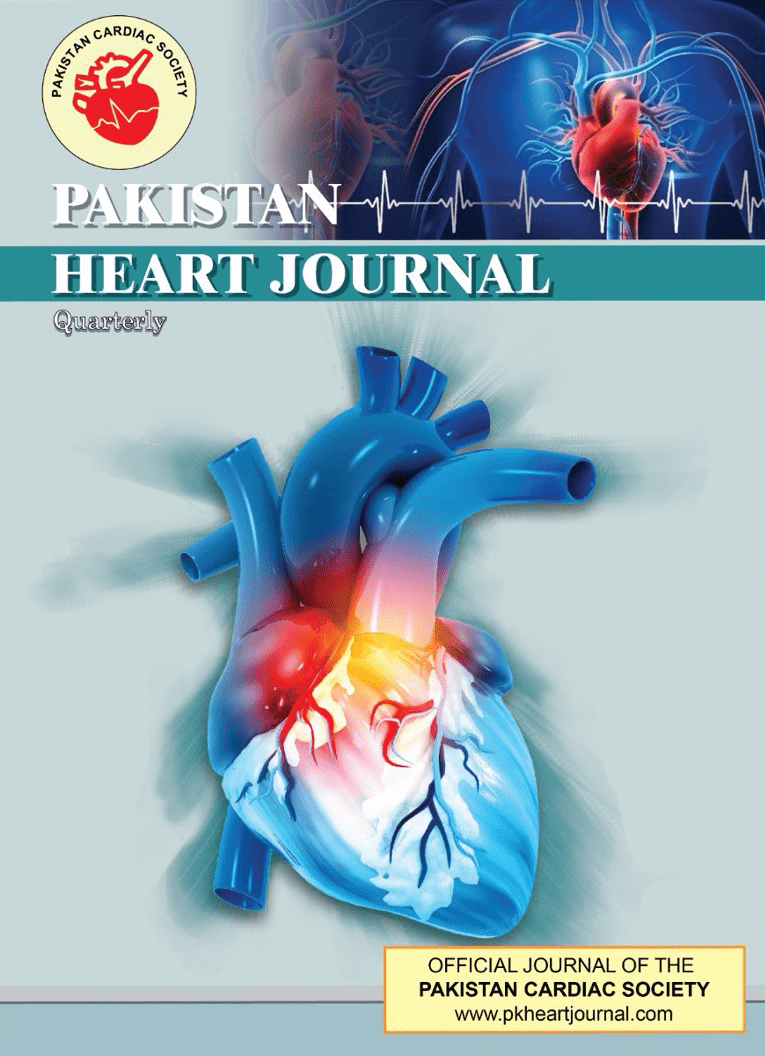THE NEED FOR OPTIMUM NUTRITIONAL STRATEGIES FOR CARDIOVASCULAR HEALTH IN PAKISTANI POPULATION
Main Article Content
Abstract
The cardiometabolic health spectrum that encompasses atherosclerotic cardiovascular disease (ASCVD), dysglycemia, hypertension, diabetes, dyslipidemia, and their sequelae are associated with several contributing factors, including high caloric intake and poor-quality diet.1 ASCVD and diabetes are closely associated, and both are increasing worldwide, particularly in the developing world.2 Pakistan is part of the South Asian subcontinent with a high prevalence of ASCVD and diabetes. Besides many other factors, the composition, quality, and quantity of the food consumed in the South Asian subcontinent appear to play a significant role in the manifestation of these diseases.3
Pakistan has an extensive array of geographical regions, ethnicities, and cultures that determine their dietary patterns and lifestyle choices.4 When compared with India, Pakistani food has always been based on more animal proteins.5 Recent socioeconomic growth and exposure to other cultures, particularly the Western and Middle Eastern influence have affected Pakistan’s dietary patterns.6 Food choices have become more energy-dense with higher calories and high-fat content, including excessive use of saturated and trans-fat containing ingredients.7 The non-communicable diseases (NCDs) risk factor survey showed that 96.5% of the participants were consuming an unhealthy diet.6 The variety of food choices together with increasing use of sugar-sweetened carbonated and non-carbonated beverages and lack of physical activity has led to an overall increase in the body weight and prevalence of obesity in society over the last two to three decades. These factors have resulted in a significant rise in the incidence of cardio-metabolic diseases.2 More importantly, these new trend has affected our younger population with the onset of diabetes and ASCVD at an earlier age.7-9
Most of the research on nutrition, dietary patterns, and their association with CVD has been conducted in developed and resource-rich populations.10 Specific diets that are associated with better cardiovascular morbidity and mortality include the Mediterranean style, Dietary Approaches to Stop Hypertension (DASH) style, Healthy US-Style, and healthy vegetarian style diets.11-13 The guidelines on diet and nutrition for cardiovascular health from the major societies (AHA/ACC, European Society of Cardiology) are mostly based upon the data from the above mentioned dietary styles.14 Pakistan lacks applied nutritional guidelines that can be adapted for our general and patient populations. A valuable resource, Pakistan Dietary Guidelines for Better Nutrition (PDGN) was published by the Ministry of Planning, Government of Pakistan 2019 However; it is not formally incorporated into guidelines for our medical societies or resulted in meaningful governmental policies.15
Therefore, there is an urgent need to address the lack of framework on nutrition for Pakistani population. Not only a review and improvement in our diet is required, other aspects of primary and secondary prevention related to lifestyle modification need also to be incorporated. This necessitates a need to develop a national policy to focus on all aspects of improving cardiovascular health and to address the issues related to the advertisement of unhealthy food choices on electronic and print media. This approach has been taken up by the developed world with significant results in health for their populations.16 There has been a gradual reduction in smoking and consumption of fast food through national policies and promotion of measures such as availability of food labeling, reduction of trans fat content in the food, and encouragement of exercise and physical activity through the availability of playing areas, cycling routes and sports in schools.8,9 Similarly, a more recent change in imposing a tax levy on sugar-sweetened beverages has improved the uptake of sugar-free carbonated drinks.17
Comprehensive diet and nutrition policies and guidelines must be developed, with the participation of all the stakeholders, at a national level and endorsed by the Government, and to fully resource the implementation across Pakistan. National guidelines on diet and nutrition must be based on a deeper understanding of the geographical, cultural, social, and economic situation of Pakistan. There are huge wealth inequalities in Pakistan leading to pockets of the population where there is an abundance of unhealthy foods consumed due to the adoption of Western style fast-food choices. More epidemiological and scientific work is required to learn the extent of the problem, particularly the role of our current diet as a causative factor in cardio metabolic diseases specific to the Pakistani population.
Working closely with the education sector to build nutritional and healthy lifestyle advice into the core curriculum would allow access to a significant proportion of the population. This will accentuate the critical role of initiating heart-healthy dietary habits early in life. Given the limitations of resources available, we must adopt and incorporate innovative and novel solutions to influence and educate our local population based on consistent standard guidelines. For example, social media and IT-based solutions are being utilised to educate and follow up participants in the HEAL-Ramadan and COMET-Health Programmes. A majority of our population has access to information through either social media or mass media (electronic and print). The use of this approach is found to be cost-effective, easily reproducible, and less labor-intensive for public health education, a very important aspect of lifestyle measures programs. For inclusivity, we must also explore education interventions for parts of the Pakistan population for which an electronic-based program may not be suitable.
A clinical review in the next quarter’s issue of Pakistan Heart Journal and a position paper later in the year on this subject will further highlight this important aspect of cardiovascular health. Our current editorial provides an outline and syntax for future work in this important area. We propose that the framework provided should be deliberated and discussed with other key stakeholders to develop comprehensive national guidelines incorporating the input from the relevant quarters. Furthermore, dietary guidelines must form an essential aspect of primary and secondary management of the cardio-metabolic disease spectrum and must include other facets of lifestyle measures, such as optimal body mass index, exercise, and cessation of smoking in the population.

